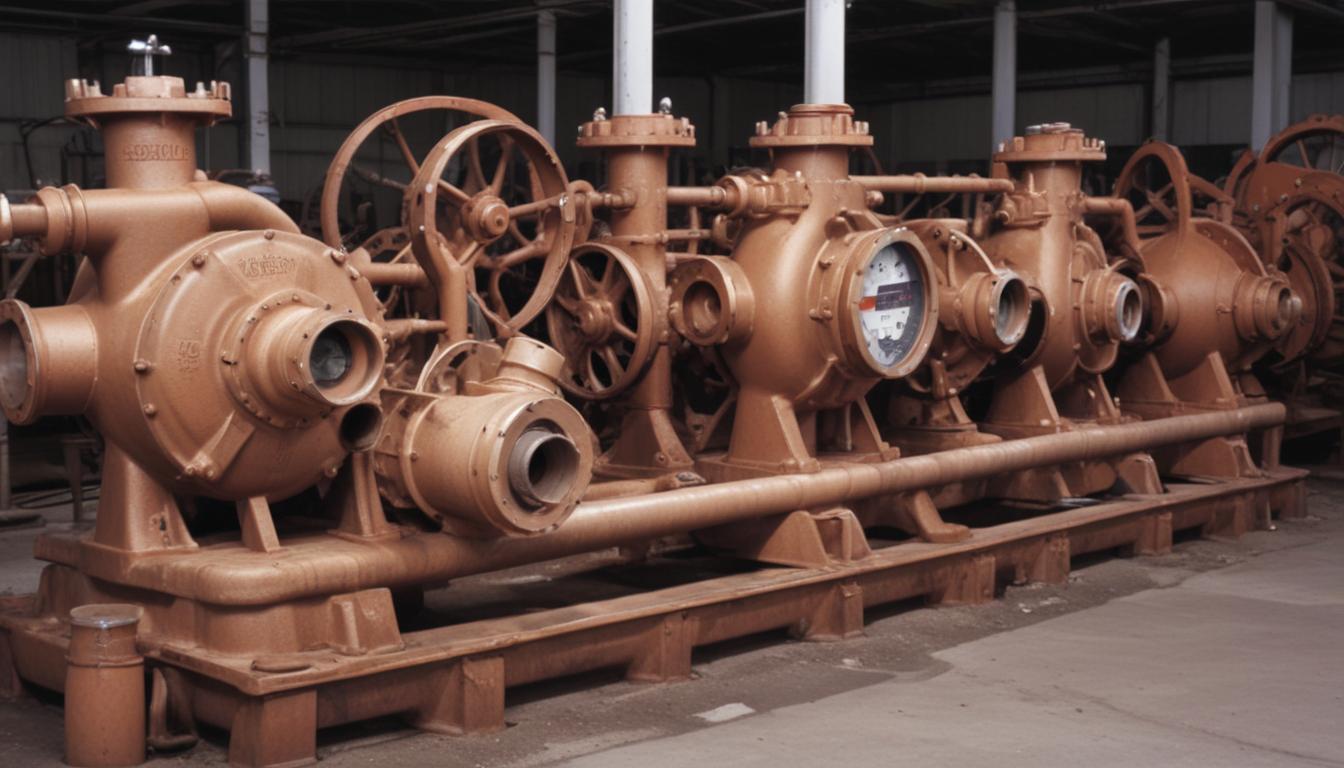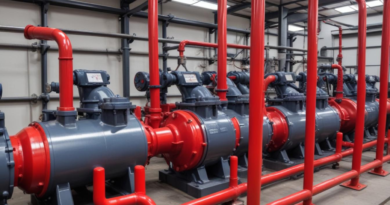Different pump types have distinct operational characteristics and, consequently, unique maintenance needs. Adhering to specific maintenance best practices for each pump type is crucial for developing effective pump maintenance schedules.
| Pump Type |
Maintenance Needs |
| Centrifugal Pumps |
- Regularly inspect impellers and casings for wear and corrosion.
- Ensure proper alignment of the pump and driver to prevent excessive vibration.
- Monitor and maintain bearing lubrication to extend component life.
|
| Positive Displacement Pumps |
- Check seals and valves frequently for leaks and wear.
- Lubricate moving parts according to manufacturer’s guidelines.
- Inspect for signs of pulsation or vibration that may indicate internal issues.
|
| Submersible Pumps |
- Regularly clear debris and blockages from the pump intake.
- Inspect electrical connections for signs of corrosion or damage.
- Ensure the motor is adequately cooled to prevent overheating.
|
| Rotary Pumps |
- Inspect seals and gaskets for integrity and replace as necessary.
- Monitor the condition of rotary components for signs of wear.
- Maintain proper alignment and balance to minimize vibration and wear.
|
daily maintenance tasks
Regular daily maintenance is essential to ensure the reliable and efficient operation of pumps. Adhering to daily maintenance schedules helps identify potential issues early, minimizing downtime and extending the lifespan of pump equipment. Implementing these best practices ensures that pumps function optimally and safely.
- Visual Inspections: Conduct a thorough visual check of the pump and its surrounding area for any signs of leaks, unusual noises, or vibrations. Look for visible wear and tear on components such as hoses, seals, and connections.
- Monitor Operational Parameters: Regularly review pressure gauges, flow meters, and temperature indicators to ensure the pump is operating within the specified parameters. Deviations may indicate underlying issues that need immediate attention.
- Check for Leaks: Inspect all seals, gaskets, and joints for any signs of leakage. Addressing leaks promptly can prevent further damage and maintain system efficiency.
- Clean Pump Intakes: Ensure that pump intake screens or strainers are free from debris and blockages. Clean them as necessary to maintain proper flow and prevent damage to internal components.
- Verify Alarm Systems: Test alarm and safety systems to confirm they are functioning correctly. This includes checking electrical connections and ensuring that warning indicators are operational.
- Lubrication: Check the lubrication levels of moving parts, such as bearings and shafts. Replenish lubricants according to manufacturer recommendations to reduce friction and prevent wear.
- Inspect Electrical Connections: Examine all electrical connections for signs of corrosion, damage, or loose fittings. Secure and repair connections as needed to maintain electrical integrity.
- Record Keeping: Maintain detailed logs of daily maintenance activities, including any observations, actions taken, and measurements recorded. This documentation aids in tracking the pump’s performance and identifying recurring issues.
Implementing these daily tasks as part of a comprehensive pump maintenance schedule not only enhances operational efficiency but also contributes to the longevity and reliability of pump systems. Consistent application of these best practices ensures that pumps remain in optimal condition, reducing the likelihood of unexpected failures and costly repairs.
weekly and monthly maintenance schedules
Adhering to structured maintenance rhythms on a weekly and monthly basis is essential for sustaining pump performance and preventing unexpected failures. Integrating these tasks into your pump maintenance schedules aligns with industry best practices, ensuring that all components operate efficiently and reliably over time.
| Frequency |
Maintenance Tasks |
| Weekly |
- Check Alignment: Verify the alignment between the pump and its driver to prevent excessive vibration and reduce wear on components.
- Inspect Mechanical Seals: Examine all mechanical seals for signs of leakage, cracking, or wear. Replace seals as necessary to maintain integrity.
- Test Safety Devices: Ensure that pressure relief valves, shut-off switches, and other safety mechanisms are functioning correctly to safeguard the system.
- Review Lubrication: Assess the lubrication levels of bearings and other moving parts, replenishing lubricants according to manufacturer recommendations.
- Analyze Operational Data: Monitor key performance indicators such as flow rates, pressures, and energy consumption to identify any irregularities.
|
| Monthly |
- Clean Pump Components: Perform a thorough cleaning of pump casings, impellers, and intake screens to remove debris and prevent blockages.
- Inspect Electrical Systems: Examine all electrical connections, wiring, and control panels for signs of corrosion, damage, or loose fittings.
- Assess Bearing Conditions: Conduct detailed inspections of bearings for overheating, noise, or vibrations that may indicate wear or misalignment.
- Calibrate Instruments: Calibrate pressure gauges, flow meters, and other instrumentation to ensure accurate readings and reliable data.
- Update Maintenance Logs: Record all maintenance activities, observations, and any corrective actions taken to maintain comprehensive documentation.
- Perform Vibration Analysis: Utilize vibration monitoring tools to detect imbalances or misalignments that could lead to more significant issues if left unaddressed.
|
Implementing these weekly and monthly maintenance tasks as part of your overall pump maintenance schedule not only enhances operational efficiency but also extends the lifespan of pump equipment. Regular attention to these areas ensures that pumps remain in optimal condition, reducing the likelihood of unplanned downtime and costly repairs.
seasonal and annual maintenance checks
 Regularly conducting seasonal and annual maintenance checks is vital for sustaining the performance and longevity of pump systems. These comprehensive inspections and tasks address wear and tear that may not be evident during daily or monthly maintenance, ensuring that pumps continue to operate efficiently under varying conditions throughout the year.
Regularly conducting seasonal and annual maintenance checks is vital for sustaining the performance and longevity of pump systems. These comprehensive inspections and tasks address wear and tear that may not be evident during daily or monthly maintenance, ensuring that pumps continue to operate efficiently under varying conditions throughout the year.
| Frequency |
Maintenance Tasks |
| Seasonal |
- Comprehensive Inspection: Perform a detailed examination of all pump components, including impellers, seals, and bearings, to identify signs of wear, corrosion, or damage that may have occurred over the season.
- System Cleaning: Thoroughly clean the pump housing, intake screens, and other related parts to remove accumulated debris, which can impede performance and cause blockages.
- Performance Testing: Assess the pump’s efficiency and output by conducting flow rate and pressure tests. Compare these metrics against baseline data to detect any deviations.
- Lubrication Maintenance: Replenish and, if necessary, upgrade lubricants for moving parts to ensure optimal operation and reduce friction-related wear.
- Environmental Assessment: Evaluate the pump’s operating environment for any changes that could affect performance, such as temperature fluctuations or exposure to corrosive substances, and make necessary adjustments.
- Update Maintenance Logs: Document all findings, actions taken, and any recommendations for future maintenance to maintain a comprehensive record of the pump’s condition and history.
|
| Annual |
- Full System Overhaul: Disassemble major pump components for in-depth inspection, cleaning, and replacement of parts that show significant signs of wear or damage.
- Seal and Gasket Replacement: Replace all seals and gaskets to prevent leaks and ensure airtight and watertight connections within the pump system.
- Calibration of Instruments: Calibrate all measuring instruments, including pressure gauges and flow meters, to guarantee accurate operational readings and data collection.
- Electrical System Review: Inspect and test all electrical connections, wiring, and control systems for integrity and functionality, addressing any issues such as corrosion or wear.
- Vibration and Noise Analysis: Conduct thorough vibration and noise assessments to identify imbalances, misalignments, or other issues that could lead to mechanical failures.
- Energy Efficiency Evaluation: Analyze the pump’s energy consumption patterns to identify opportunities for improving efficiency and reducing operational costs.
- Training and Review: Provide training sessions for maintenance staff on updated procedures and best practices, ensuring that the team is well-equipped to handle pump maintenance effectively.
- Review and Update Maintenance Schedules: Assess the current maintenance schedules and adjust them based on the pump’s performance data and any changes in operational demands to optimize maintenance effectiveness.
|
Implementing these seasonal and annual maintenance tasks as part of a structured pump maintenance schedule ensures that all aspects of the pump system are thoroughly evaluated and maintained. Adhering to these best practices not only enhances the reliability and efficiency of pumps but also minimizes the risk of unexpected downtime and extends the overall lifespan of the equipment.
troubleshooting and corrective actions
Effective troubleshooting is a critical component of maintaining the operational integrity of pump systems. By systematically identifying and addressing issues, organizations can prevent minor problems from escalating into significant failures. Implementing structured corrective actions as part of your pump maintenance schedule ensures that pumps remain reliable and efficient. Below is a comprehensive overview of common pump issues, their potential causes, and recommended corrective actions:
| Issue |
Possible Causes |
Corrective Actions |
| Pump Fails to Start |
- Electrical power loss or faulty power supply
- Tripped circuit breakers or blown fuses
- Defective motor or control panel
|
- Verify power supply and ensure the pump is receiving electricity.
- Check and reset circuit breakers or replace fuses as needed.
- Inspect the motor and control panel for defects and repair or replace faulty components.
|
| Unusual Noises |
- Worn bearings or misalignment
- Air or gas trapped in the system
- Impeller damage or cavitation
|
- Inspect and lubricate or replace bearings as necessary.
- Bleed the system to remove trapped air or gas.
- Examine the impeller for damage and repair or replace it if cavitation is detected.
|
| Excessive Vibration |
- Imbalance in the rotating components
- Pump and driver misalignment
- Loose mounting or support structures
|
- Balance the rotating components to eliminate imbalances.
- Realign the pump and driver to reduce vibration.
- Tighten mounting bolts and secure support structures to minimize movement.
|
| Leaks |
- Worn or damaged seals and gaskets
- Corrosion of pump casing or fittings
- Improper installation of components
|
- Replace faulty seals and gaskets to stop leaks.
- Inspect and repair or replace corroded pump casings and fittings.
- Ensure all components are correctly installed and tightened to prevent future leaks.
|
| Reduced Performance |
- Clogged intake or discharge lines
- Worn impellers or internal components
- Incorrect pump sizing or system design
|
- Clear any blockages in the intake or discharge lines.
- Inspect and replace worn impellers or internal parts to restore performance.
- Evaluate pump sizing and system design to ensure they meet operational requirements.
|
| Overheating |
- Insufficient cooling or ventilation
- High ambient temperatures
- Electrical issues causing excessive motor load
|
- Enhance cooling systems and ensure adequate ventilation around the pump.
- Implement measures to manage high ambient temperatures, such as shading or additional cooling.
- Check electrical connections and motor load to prevent overheating due to electrical faults.
|
In addition to addressing specific issues, adopting a proactive approach to troubleshooting can significantly enhance pump reliability. Implement the following best practices to streamline the troubleshooting process:
- Establish a Baseline: Understand the normal operating parameters of your pump systems to quickly identify deviations.
- Use Diagnostic Tools: Employ vibration analyzers, thermal cameras, and flow meters to gather accurate data for diagnosing problems.
- Follow a Systematic Approach: Approach troubleshooting with a step-by-step methodology to ensure all potential causes are examined.
- Document Issues and Resolutions: Keep detailed records of problems encountered and the solutions implemented to build a knowledge base for future reference.
- Train Maintenance Personnel: Ensure that staff are well-trained in identifying and resolving common pump issues effectively.
By integrating these troubleshooting strategies and corrective actions into your pump maintenance schedules, you can maintain optimal pump performance, reduce downtime, and extend the lifespan of your equipment. Adhering to these best practices not only addresses immediate issues but also fosters a culture of continuous improvement and reliability within your maintenance operations.
 Regularly conducting seasonal and annual maintenance checks is vital for sustaining the performance and longevity of pump systems. These comprehensive inspections and tasks address wear and tear that may not be evident during daily or monthly maintenance, ensuring that pumps continue to operate efficiently under varying conditions throughout the year.
Regularly conducting seasonal and annual maintenance checks is vital for sustaining the performance and longevity of pump systems. These comprehensive inspections and tasks address wear and tear that may not be evident during daily or monthly maintenance, ensuring that pumps continue to operate efficiently under varying conditions throughout the year.



